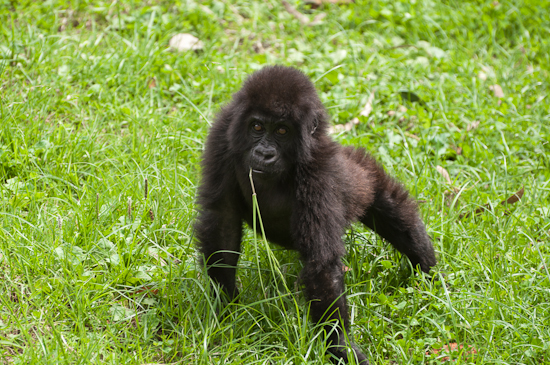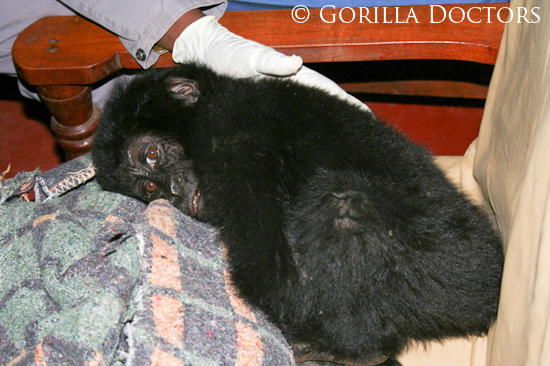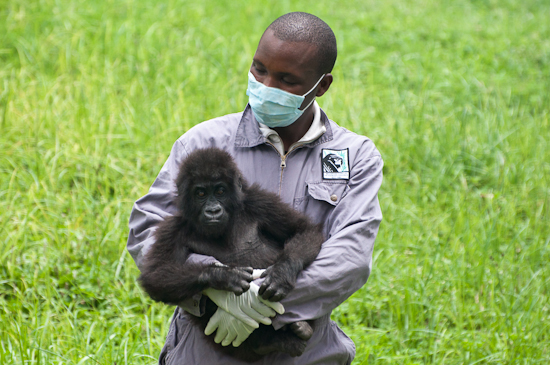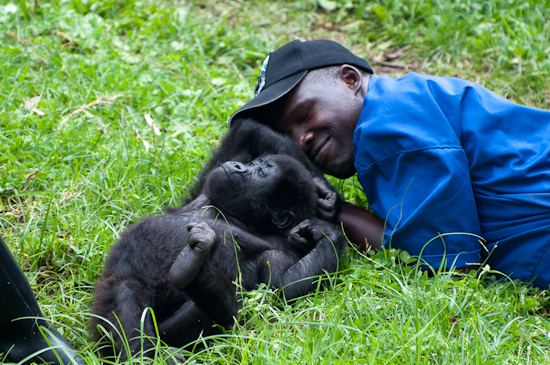DNA Tests Reveal Orphan Ihirwe to be a Grauer’s Gorilla
By Gorilla Doctors Staff on Thursday, April 19th, 2012 in Uncategorized. By Dr. Noel
By Dr. Noel
From July 23 to 27, 2011, all Gorilla Doctors veterinarians were involved in the huge and exciting event of moving the six Grauer’s gorillas that had been in the Gorilla Doctors care for years from out interim orphan quarantine facility in Kinigi, Rwanda to the GRACE sanctuary in DRC. However, only two weeks later on the night of August 7, we got a call from the Volcanoes National Park Chief Warden Prosper Uwingeli reporting the confiscation of a baby gorilla in Gisenyi, Rwanda, on the border with DRC. Prosper asked for veterinary assistance, so team of two Gorillas Doctors and one experienced gorilla caretaker packed up and drove to the police station where the gorilla was being held. They found the poor baby gorilla very stressed and coughing with a nasal discharge and poor body conditions.
 Ihirwe the night of her confiscation.After preliminary exam, the baby was brought to our quarantine facility for care and treatment. Two more caretakers were hired and I was appointed to be the gorilla’s chief veterinarian. After only two days, the baby started improving and exploring the new area.
Ihirwe the night of her confiscation.After preliminary exam, the baby was brought to our quarantine facility for care and treatment. Two more caretakers were hired and I was appointed to be the gorilla’s chief veterinarian. After only two days, the baby started improving and exploring the new area.
The next after the confiscation, we asked the caretakers to choose a name for her and they named her ”Ihirwe”. This is a Kinyarwanda name and means “luck” or “chance” it we used it to express how lucky she was to be saved from the poachers.
Ihirwe with her bottle.Before her confiscation the poachers who had her said she was kept in their house in a sack and fed potatoes and sugar canes for two weeks. In our facility we introduced her to new food including baby formula, fruits and vegetables from the market and also forest food like wild celery. For the first couple days we had troubles with the baby formula because she refused it but we kept trying to feed it to her through a syringe and surprisingly this become her favorite food.
 Dr. Noel and Ihirwe.Since she has been under the Gorilla Doctors’ care, Ihirwe has grown very close to her caretakers and me. Whenever I enter the facility she looks happy and receptive, and runs after me and climbs up on me, although she checks to see whether I am carrying any medical equipment first to make sure she is not getting a shot or otherwise restrained for an exam. If I have nothing, then we are very good friends.
Dr. Noel and Ihirwe.Since she has been under the Gorilla Doctors’ care, Ihirwe has grown very close to her caretakers and me. Whenever I enter the facility she looks happy and receptive, and runs after me and climbs up on me, although she checks to see whether I am carrying any medical equipment first to make sure she is not getting a shot or otherwise restrained for an exam. If I have nothing, then we are very good friends.
When Ihirwe came into our care, we were not able to state firmly whether she was a mountain gorilla or a Grauer’s gorilla.
There was some confusion on Ihirwe’s subspecies because the poachers said she was taken from the Bukima area of Virunga National Park, which is where mountain gorillas live. However, some people thought Ihirwe’s face appeared to look more like that of a Grauer’s gorilla than a mountain gorilla. The only way to know for sure was DNA testing. This would very important for her future because a mountain gorilla orphan would move to the Senkwekwe Center at Virunga National Park to join Maisha, Kaboko, Ndeze, and Ndakasi and a Grauer’s gorilla would move to GRACE to join the other Grauer’s gorillas.
 Ihirwe and a caretaker.
Ihirwe and a caretaker.
I really hoped Ihirwe was a mountain gorilla because then I would be able to visit her often at Senkwekwe. GRACE is difficult to reach, so I would have very little chance to see her.
We collected blood, feces, and hair samples from Ihirwe and sent them to the Max Planck Institute for Evolutionary Anthropology in Germany for analysis. The results came back that Ihirwe is a Grauer’s gorilla. We are making plans to send her to GRACE in the next few months.
I am happy Ihirwe will soon be with other gorillas but I am very sad to lose my friend! I will never forget how stressed she was when she was confiscated and when she fell out of a tree knocking out her teeth and how I was there to help her.
Background on Grauer’s Gorillas
Mountain and Grauer’s or Eastern Lowland gorillas are two different subspecies within the Eastern Gorilla Species. They are very similar genetically but are adapted to live in different environments. Mountain gorillas live at higher altitudes in the Virunga Massif and Bwindi Impenetrable Forest and have thick black hair coats to insulate their bodies from the cool mountain climate. Grauer’s gorillas live in lower altitude forests through Eastern DRC and have slightly larger bodies and less hair than mountain gorillas. The Gorilla Doctors provide veterinary to both Eastern Gorilla subspecies, although Grauer’s gorillas are much more difficult to monitor due to the insecurity of the regions where they live.
Historically, three quarters of the gorilla orphans that have come into the Gorilla Doctors care have been Grauer’s gorillas. Because many of areas where Grauer’s gorillas live in Eastern DRC are not well protected due to rebel activity, it is easier for poachers to access Grauer’s gorilla groups than mountain gorilla groups. Poacher’s target infant gorillas because of the gorillas’ perceived value as exotic pets in the illegal wildlife market.
You can follow the Gorilla Doctors health monitoring efforts on our Facebook page, where we post photos and notes from our monthly visits.
Please consider supporting MGVP by making a secure online donation. Every dollar you give goes to directly supporting our gorilla health programs and One Health initiative. Thank you for your generosity.


 Donate
Donate